
We finally have our Workboxes set up (‘though not yet in use). Here is what we have to work with.
For Littles
For Sophia, we are using a traditional Workbox setup, but scaled back. As young as she is (she’s two), I think she needs the ease of access of the regular boxes. And I really like the idea of using the schedule strip to teach her sequencing and left-to-right, top-to-bottom tracking, but I thought that twelve boxes would be overwhelming and unnecessary for her at this stage. So we are starting with three, and this schedule strip.
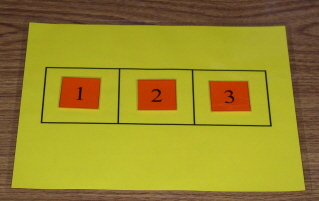
There’s very little to it – just enough that she can begin learning to read it from left to right. She will take these orange number “squares” off and match them up to the white number “squares” (they’re really rectangular) on her boxes to know which boxes to do. This should help her learn number recognition, as well. For this photograph, the boxes aren’t sitting where they will ultimately be (they’re on a table here), but this is what they look like.
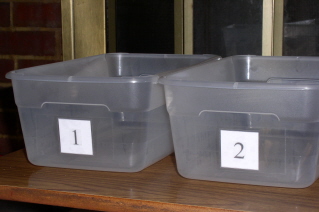
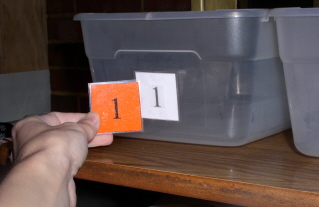
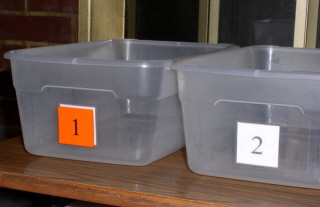
When she gets a little more experienced with this, I will add three more boxes and we will switch to this schedule strip.

That way she can begin to learn the concept of moving from top to bottom as well as from left to right.
For Middle-ish Kids
Ariel’s “Workboxes” are really a single workbox. We have this file crate (It’s made by Neu Home and was ordered from Walmart.com, for anyone who may be curious).

Her schedule grid is velcroed to the side of the crate. (The back side of the velcro didn’t want to stay attached, though. We’ll see if the adhesive “cures” enough after a few days for that to actually work. The idea was to be able to remove it if we wanted to just be looking at a nice file crate, for some reason, rather than a purple plastic chart.)

The numbers are velcroed to this, as well. They can be removed and moved around, and other, non-box labels could be attached. At the moment, though, I don’t foresee a need for that. In the center of the box is a divider that I made by taping a file folder to a hanging file folder.
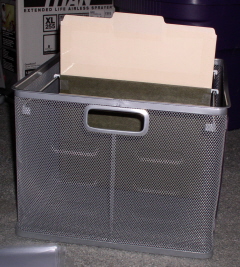
The idea is for her assignments to be placed in front of this divider. As she completes each one, Ariel will move its bag to the back of the crate, behind the divider. In this way, the work will “disappear” as it is completed, much like in the original workbox system.
For holding each assignment, we are using two-gallon Ziploc bags. They should accommodate large flat items like binders and textbooks, or “stretch” to accommodate smaller, but more three-dimensional activities like a container full of pattern blocks.
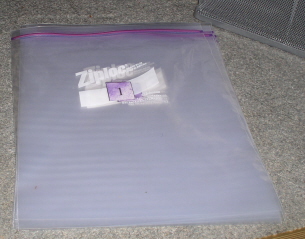
They’re labeled with squares, just like Sophia’s workboxes are.
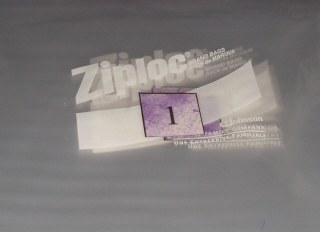
The bags are clear, providing the visual component inherent in the original workbox system. Unfortunately, they are also so flimsy that they won’t stay upright in the crate while they’re empty. I think I am going to buy a dozen (portfolio-style) folders to go inside them to give them structural support. Workbooks, etc. can just slide in, in front of the folders, as though they weren’t there. But that would also give me a place to put individual worksheets, if necessary. Or something to stick a sticky note to. [EDIT 7/12/2011: The folders did/do work well.]
Maybe this will show up in a few weeks in a Works for Me Wednesday post. But right now it has yet to be tested and tweaked.
For Older Students
I saw a terrific idea this morning for an adaptation that may work very well for us as we approach the acne treatment and driver’s license stage. One mom is using bound-together folders for her children’s work, one assignment to each folder. This progression could be a good way to wean our children from our imposed structure to self-imposed task management. The individual workboxes “evolve” into a single workbox, which evolves into a single “notebook” with individual folders, which evolves into a single folder that the student needs to manage on his own. I like this idea. [EDIT 7/12/2011: This past year we used the bound-together folders for Ariel. They also worked well, and we do like the progression. There is more on this in other posts.]
(For more adaptations, check out my Workboxes Around the Web post.)
[…] have just this year begun using a variation of Workboxes for our homeschool. (For those of you who are new to the idea of Workboxes, they are not a […]